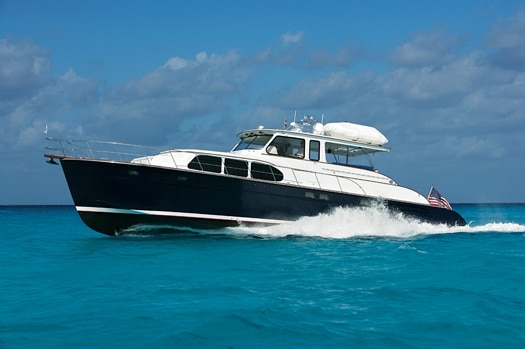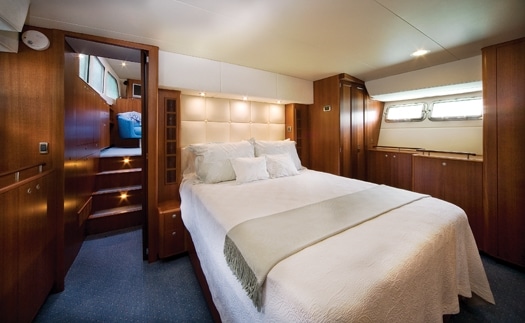
Huckins 60
There has always been something comforting to me about a new Huckins taking to the water. Through good times and bad, it is the culmination of a process that has continued without interruption since Frank Pembroke Huckins founded the yard in 1928 on Lakeshore Boulevard in Jacksonville, Florida. In recent history, a trendy palette of boating brands has joined the yachting fold. But, for the knowledgeable yachtsman, the Huckins mark remains a historical touchstone and the builder’s products a relief from the mainstream. La Belle Hélène, Huckins latest launch, is a perfect example.
I spent time aboard La Belle Hélène with her owners Helen and Frank Morneau and yard owners Cindy and Buddy Purcell. Cindy is the granddaughter of Frank Huckins and has been running the business with her husband Buddy since her late father retired in 1980. The Morneaus hail from Toronto and are experienced boaters and members of the Royal Canadian Yacht Club. They were familiar with the yard because a close relative had owned and enjoyed a Huckins for many years. The Morneaus have had quite a few boats and raised quite a few boaters.
“We had been looking at a 44 Huckins but a bigger boat made more sense, considering our five kids and twelve grandchildren,” said Frank Morneau. “The problem was draft, as water levels are down in the Great Lakes.” The Morneaus sea trialed a larger Huckins fitted with waterjets and were sold.
There is no mistaking the origins of La Belle Hélène’s design. Frank Huckins’s vision of building a faster yacht was not revolutionary. While others were challenging the speed envelope by simply adding horsepower, Huckins looked at the design as a whole. He fretted over every detail from scantlings and interior specifications to weight distribution and hydrodynamics. Huckins’s boats were built one way-Frank Huckins’s way. Those that did not understand this, whether employee or customer, were politely sent elsewhere.
After Huckins’s death in 1951, the yard explored new markets by building sportfishing boats as well as conventional and not-so-conventional motoryachts-a 50-foot, outboard-powered cruiser comes to mind. In the 1990s, Purcell recognized the value of the Huckins pedigree and tastefully brought some of the yard’s classic designs up to date. These designs are not retro. Instead, they are the real deal.
“At the time we noticed that people were interested in classic design, from cars to clothes,” said Purcell. “Our updated designs from the 1950s and 1960s have driven our production ever since.” La Belle Hélène is hull number 456 and is based on the Huckins 56 Linwood model, originally introduced in 1950. Her reverse transom masks an integral swim platform, which seems a practical compromise to tradition and accounts for her length overall (60 feet, 3 inches). Her styling has been refined: It’s a bit softer and has more curves than Frank Huckins might have liked. Such features were not efficient in wood construction. The gentle rise of her slightly reverse sheer, her proud chine, and the conservative rake of her stem are trademark Huckins. So too is the sensible cut of her deckhouse and the sweep of her rails. Custom-cast deck hardware and hatches that Frank Huckins patented in the 1950s accent these styling cues. But La Belle Hélène’s rich dark-blue hull and white house are in tune with the times. In Frank Huckins’s day it would have been light gray for the hull and off-white for the superstructure and interior. While Huckins insisted his goal was to reduce eye fatigue, I suspect production efficiency was also a consideration.
When the original Linwood was launched she was the largest offering in the Huckins fleet and larger than most of the yachts on the waterway. Her design was penned in response to demand for a boat with split accommodations-crew forward and owner aft. Boating has changed over the years and is now more hands-on in this size range. La Belle Hélène’s layout suits the Morneaus, who prefer to run the boat themselves. Her bridge has a teak and holly sole and is arranged with a lounge area aft and a helm station forward with comfortable Recaro seating. Pantograph doors adjacent to the helm allow convenient access to the side decks for handling lines. The covered exterior cockpit has a gate for access to the swim platform.

| | |
Below, the split-level main cabin has a seating area and an open galley. A full-beam master stateroom is just aft and has a queen berth. His-and-hers heads share a central bath and the compartment serves as a sound buffer, isolating the machinery space aft. A guest cabin with two berths is forward and has private access to the day head. Fit and finish throughout are in keeping with Huckins’s high standard. The Morneaus chose satin-finished makore and worked directly with Huckins on the interior décor.
Prewar Huckins yachts were plank on frame with an additional layer of diagonal planking below the waterline to keep the bilges dry. In his passion to reduce unnecessary weight, Frank Huckins later pioneered laminated wood structures, “donating” his patent for a laminated internal keel and his scantlings for double- and triple-diagonal planking to the war effort.
While Frank Huckins anticipated the fiberglass revolution, he would not live to witness it. In his spirit, the yard was one of the first to experiment with foam-cored fiberglass hulls. The result was a structure that was competitive with wood in terms of weight. The yard has continued to refine this technology since the 1970s.
La Belle Hélène’s cored hull was built over a male plug. The inside skin was laminated first. The core was vacuum-bagged in place, and then the outer skin was laminated, faired, and finished. Foam-cored structural bulkheads and web frames support foam-cored fiberglass longitudinal stringers. These stringers also serve as foundations for the engines, which are mated to the waterjets with 33-inch jackshafts. Frank Huckins understood the importance of keeping weight aft in faster designs. Access to the engineroom is from the cockpit and larger hatches are provided for more serious work.
La Belle Hélène is the second Linwood to be fitted with waterjet propulsion. While waterjets take a bit of getting used to, they seem a good fit for the slippery Huckins hull form. In terms of performance, Huckins have a distinctive feel I find exhilarating. They rise quickly and evenly without tabs fitted and bank much less than boats with even modest transom deadrise-Huckins typically have 6 degrees. While there is no keel, they track predictably and their light weight and horsepower serve well around the dock. I would add that with waterjet power the bow thruster is quite useful. La Belle Hélène is fitted with a pair of 715-horsepower Cummins diesels. While this is modest power for a boat her size, she needs no more. I recorded a maximum speed of 31.2 knots, and found 2300 rpm (almost 25 knots) a pleasant setting. At this speed she burns 55.6 gallons an hour. As the Morneaus’ float plan extends from Canada to the Bahamas, the efficient Huckins hull form makes good sense.
La Belle Hélène will summer in Georgian Bay and winter at the Sarasota Yacht Club in Florida. If you are fortunate, you may spot her underway somewhere in between. She is an eye-pleasing distraction from the mainstream, and solid evidence that good design is always in fashion.
Huckins Yachts, (904) 389-1125; **www.huckinsyacht.com**








